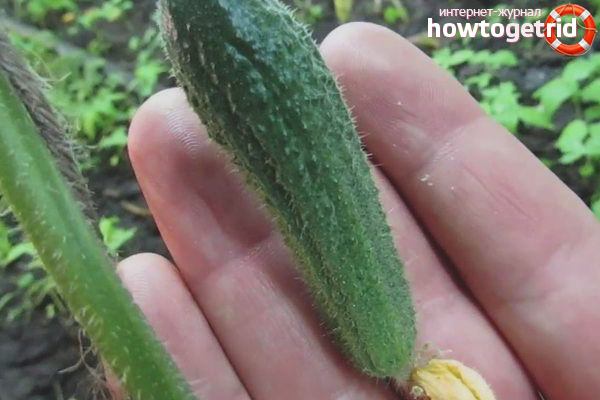The content of the article
The market is widely developed in the modern world, and it is able to offer the buyer seeds of cucumbers of any varieties. There are also hybrid species, one of which is known as Coldin F1.
Grade description
This variety belongs to hybrids of the F1 category. It is characterized by high productivity and bears fruit for a long time. The plant extends up to 1.5 meters in height, and one node brings up to 7 fruits. The bush branches moderately, the fruits are ready for use 39-40 days after planting.
The benefits of the variety include:
- the plant is resistant to external harmful factors;
- does not require pollination.
As for the fruits, their length reaches 9 centimeters and their weight is 90 grams. The peel is covered with small tubercles and light longitudinal stripes. One cucumber contains many useful trace elements - they have a positive effect on the gastrointestinal tract, remove cholesterol and toxins from the body.
Landing and care
Landing Features
Actual time for landing falls in the spring. Prepared seeds are pre-soaked in a special solution containing water and minerals. After the seeds have dried, they are planted, which will require high-quality soil and small pots. Watering should be plentiful and as the soil dries.
After landing care
Proper care of cucumber bushes of the Claudine variety F1 implies compliance with the following rules:
- timely weed control;
- maintaining cleanliness on the site;
- daily watering in moderation;
- tying the growing shoots;
- the destruction of pests, if any.
It will also be useful for cucumbers to receive top dressing from fertilizers containing mineral substances. The approximate proportions of which are 20 grams of substance per 1 liter of water.
Diseases and pests affecting the plant
The appearance of pests or diseases in a plant is always an alarming sign. If you do not intervene, the plant can seriously suffer and even die.
Cucumber bushes affect pests such as:
- Aphid. Looks like a little green bug. Aphid colonies populate the leaves and eat them, leading to wilting. Ladybugs or a solution of soap (20 g), water (2, 5 l) and wood ash (50 g) will help to destroy the pest.
- Spider mite. After its life, leaves a web under the leaves. From it will help spraying with a solution of 10 grams of soap diluted in a liter of water.
- Whitefly The whisker is whitish. Drinks juice from a plant. The consequences of her stay are mushrooms resembling soot and lethargy of leaves. Garlic with water will help in the destruction (150 grams of garlic per 1 liter of water).
The diseases of this variety of cucumbers include:
- Viscous, white rot. Leads to the death of a cucumber shoot. Water treatment with zinc, copper sulphate and urea content will help to cure the bush (all components are added to two liters of water - 10 g each).
- Downy mildew. It looks like yellow spots localized on the foliage. Leaves the whole plant to dry. To defeat the disease, it is necessary to stop watering and top dressing for 4 days, followed by ten grams of polycarbacin diluted in 5 liters of water.
- Cladosporiosis. Brown sores that visually make the fruit look rotten. In this case, watering is stopped for 5 days and, after removing the affected parts, they are treated with foundationazole (10 grams per 0.5 liter of water).
- Powdery Mildew White spots on leaves and other parts of the bush. The disease stops bearing, and the leaves dry out. At the initial stage, trimming of the affected parts and treatment with fungicides (10 g per 5 liters) will help. A plant with a neglected form is destroyed.
When treating a hybrid, all affected areas of the bush must be removed. Excessive spraying and non-compliance with the proportions of the drug can be fatal.
Growing Tips
- Knowing some of the features of growing cucumbers will be very welcome. The right advice will allow you to collect a quality crop with minimal losses.
- Initially, cucumbers grew in a warm Indian climate. When planting on seedlings, the soil should be warm, and the air temperature in the room should not fall below 14 degrees.
- It is better to plant seeds that have lain for 2-3 years. They will give more female flowers and reduce the risk of developing diseases. Strongly fresh seed can produce a powerful shrub and meager harvest.
- It is worth sowing cucumbers at the end of April, placing seedlings under the film before emergence. The optimum temperature regime during this period is +28 degrees.
- The soil should have an admixture of peat and humus in 1: 1 proportions. Wood ash and a tablespoon of fertilizer are added to it.
- Planting is carried out at the end of May, in soil containing 5-6 kilograms of humus. Productivity depends on its composition.
- It is not recommended to remove healthy leaves, the quality of the crop depends on each of them.
- Timely harvesting will accelerate the formation of new fruits.
Cucumber Claudine F1 is a good and high-quality hybrid. With timely watering and proper care, the bush of the plant will delight you with an abundance of fruits with high taste and will not leave indifferent even the most picky gardeners.
Video: Claudine F1 cucumbers










Submit